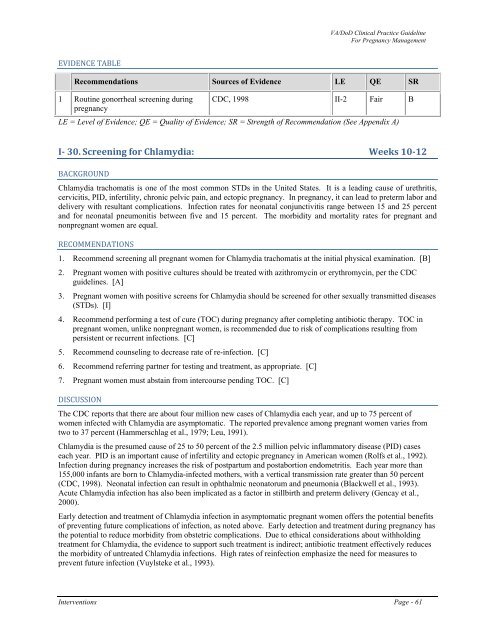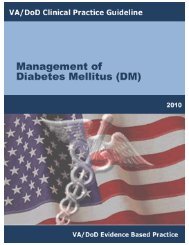Management of pregnancy - VA/DoD Clinical Practice Guidelines ...
Management of pregnancy - VA/DoD Clinical Practice Guidelines ...
Management of pregnancy - VA/DoD Clinical Practice Guidelines ...
You also want an ePaper? Increase the reach of your titles
YUMPU automatically turns print PDFs into web optimized ePapers that Google loves.
<strong>VA</strong>/<strong>DoD</strong> <strong>Clinical</strong> <strong>Practice</strong> Guideline<br />
For Pregnancy <strong>Management</strong><br />
EVIDENCE TABLE<br />
Recommendations Sources <strong>of</strong> Evidence LE QE SR<br />
1 Routine gonorrheal screening during CDC, 1998 II-2 Fair B<br />
<strong>pregnancy</strong><br />
LE = Level <strong>of</strong> Evidence; QE = Quality <strong>of</strong> Evidence; SR = Strength <strong>of</strong> Recommendation (See Appendix A)<br />
I 30. Screening for Chlamydia: Weeks 1012<br />
BACKGROUND<br />
Chlamydia trachomatis is one <strong>of</strong> the most common STDs in the United States. It is a leading cause <strong>of</strong> urethritis,<br />
cervicitis, PID, infertility, chronic pelvic pain, and ectopic <strong>pregnancy</strong>. In <strong>pregnancy</strong>, it can lead to preterm labor and<br />
delivery with resultant complications. Infection rates for neonatal conjunctivitis range between 15 and 25 percent<br />
and for neonatal pneumonitis between five and 15 percent. The morbidity and mortality rates for pregnant and<br />
nonpregnant women are equal.<br />
RECOMMENDATIONS<br />
1. Recommend screening all pregnant women for Chlamydia trachomatis at the initial physical examination. [B]<br />
2. Pregnant women with positive cultures should be treated with azithromycin or erythromycin, per the CDC<br />
guidelines. [A]<br />
3. Pregnant women with positive screens for Chlamydia should be screened for other sexually transmitted diseases<br />
(STDs). [I]<br />
4. Recommend performing a test <strong>of</strong> cure (TOC) during <strong>pregnancy</strong> after completing antibiotic therapy. TOC in<br />
pregnant women, unlike nonpregnant women, is recommended due to risk <strong>of</strong> complications resulting from<br />
persistent or recurrent infections. [C]<br />
5. Recommend counseling to decrease rate <strong>of</strong> re-infection. [C]<br />
6. Recommend referring partner for testing and treatment, as appropriate. [C]<br />
7. Pregnant women must abstain from intercourse pending TOC. [C]<br />
DISCUSSION<br />
The CDC reports that there are about four million new cases <strong>of</strong> Chlamydia each year, and up to 75 percent <strong>of</strong><br />
women infected with Chlamydia are asymptomatic. The reported prevalence among pregnant women varies from<br />
two to 37 percent (Hammerschlag et al., 1979; Leu, 1991).<br />
Chlamydia is the presumed cause <strong>of</strong> 25 to 50 percent <strong>of</strong> the 2.5 million pelvic inflammatory disease (PID) cases<br />
each year. PID is an important cause <strong>of</strong> infertility and ectopic <strong>pregnancy</strong> in American women (Rolfs et al., 1992).<br />
Infection during <strong>pregnancy</strong> increases the risk <strong>of</strong> postpartum and postabortion endometritis. Each year more than<br />
155,000 infants are born to Chlamydia-infected mothers, with a vertical transmission rate greater than 50 percent<br />
(CDC, 1998). Neonatal infection can result in ophthalmic neonatorum and pneumonia (Blackwell et al., 1993).<br />
Acute Chlamydia infection has also been implicated as a factor in stillbirth and preterm delivery (Gencay et al.,<br />
2000).<br />
Early detection and treatment <strong>of</strong> Chlamydia infection in asymptomatic pregnant women <strong>of</strong>fers the potential benefits<br />
<strong>of</strong> preventing future complications <strong>of</strong> infection, as noted above. Early detection and treatment during <strong>pregnancy</strong> has<br />
the potential to reduce morbidity from obstetric complications. Due to ethical considerations about withholding<br />
treatment for Chlamydia, the evidence to support such treatment is indirect; antibiotic treatment effectively reduces<br />
the morbidity <strong>of</strong> untreated Chlamydia infections. High rates <strong>of</strong> reinfection emphasize the need for measures to<br />
prevent future infection (Vuylsteke et al., 1993).<br />
Interventions Page - 61
















